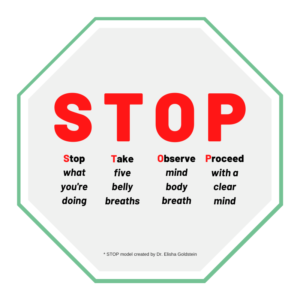Awareness of thoughts and emotions
This week we dive deeper into mindfulness. We learn to be with our thoughts and emotions.
This isn’t always a comfortable place to be. It’s important for us to be able to recognise how we feel so we can process thoughts and emotions in a constructive way.
There are no ‘positive’ or ‘negative’ emotions, all emotions are valid and each tells us an important message.
We don’t always have the words to express what’s going on inside. These exercises help kids to identify and communicate how they are feeling.
Simply S.T.O.P.
In times of stress its easy to get caught up in our thoughts and emotions. Pressing pause gives us space to return to the present moment and respond in a less reactive way.
This wonderful mindfulness practice created by Dr Elisha Goldstein can be used by both adults and children.

Stop – press pause on what you’re doing
Take – 5 slow full mindful breaths. A technique like Finger Breathing or Square Breathing can be used here
Observe – Check-in with yourself, what thoughts are you having? Can you feel the emotion anywhere on your body? How would you describe the quality of your breath?
Proceed– make a decision about what to do next. Has the emotion passed? If not, is there someone you can talk to or something you can do to release the thoughts or emotions?
Emotional body map
People feel emotions in different parts of their body. Being able to identify an emotion will help kids to recognize why they feel different bodily sensations.
These sensations are often a precursor to behaviour. When kids are able to label their emotions they can release them in a safe and healthy way.
Internal weather report
Have you ever noticed that our thoughts and emotions can change from one day to another? Just like the weather.
In this exercise children learn about the impermanent nature of our thoughts and emotions by using types of weather to describe how they feel.
